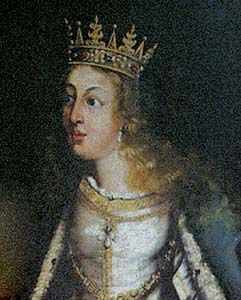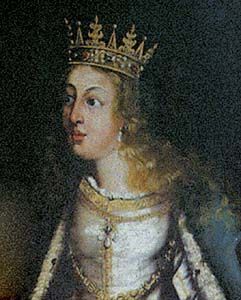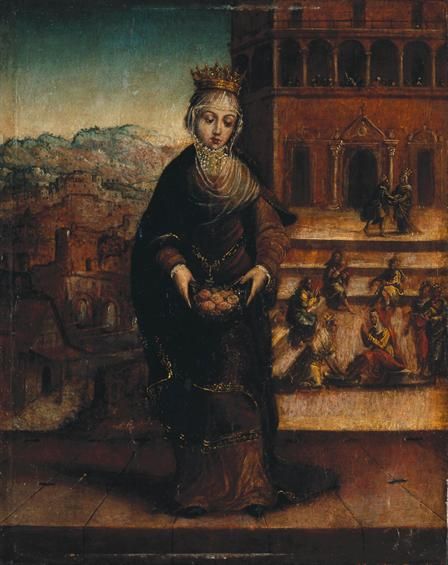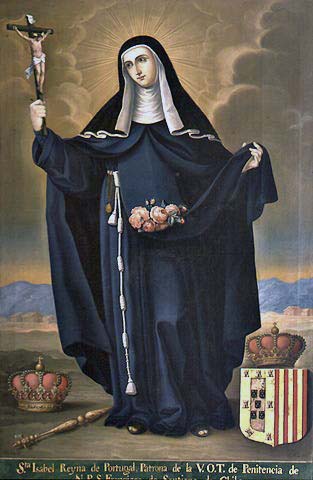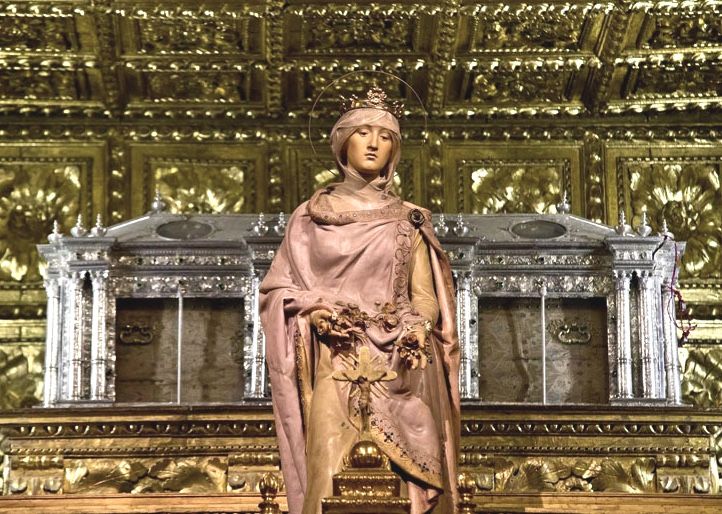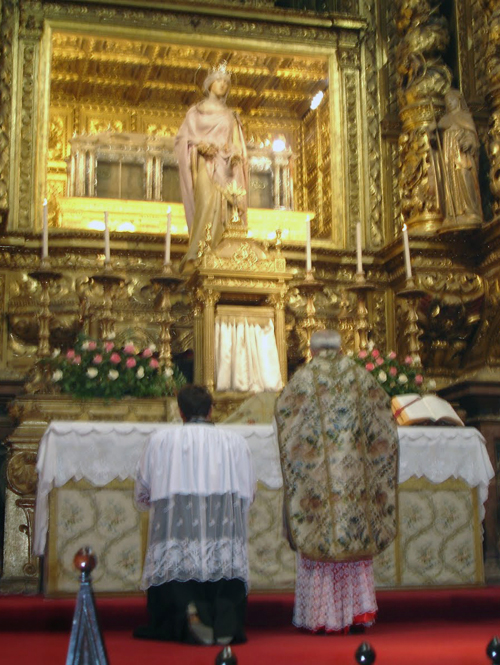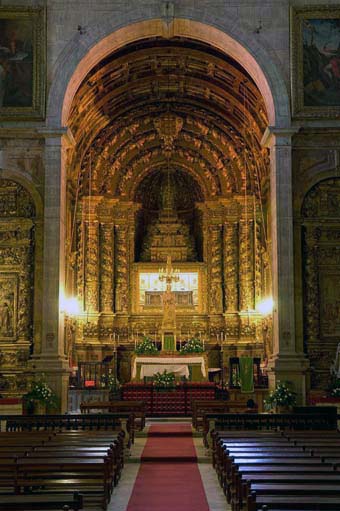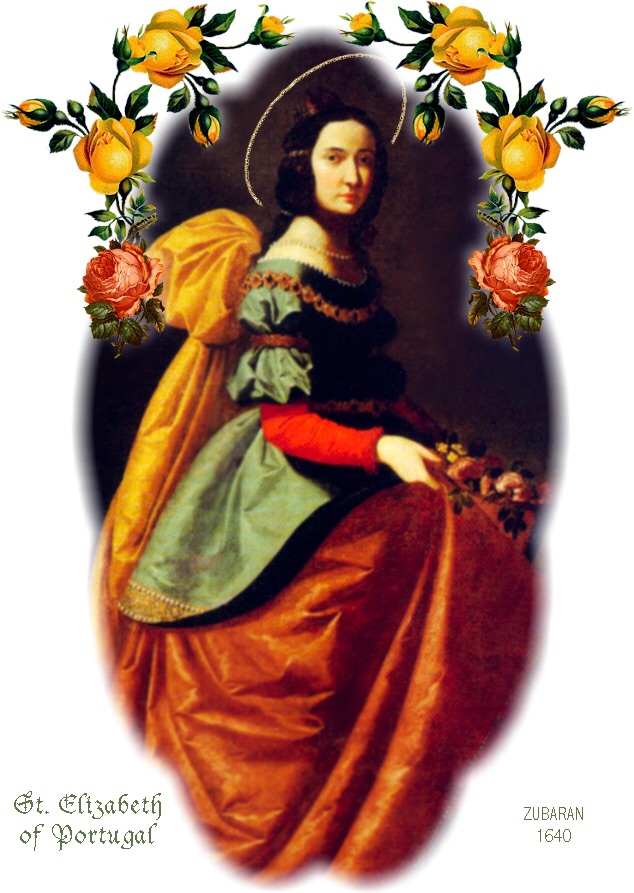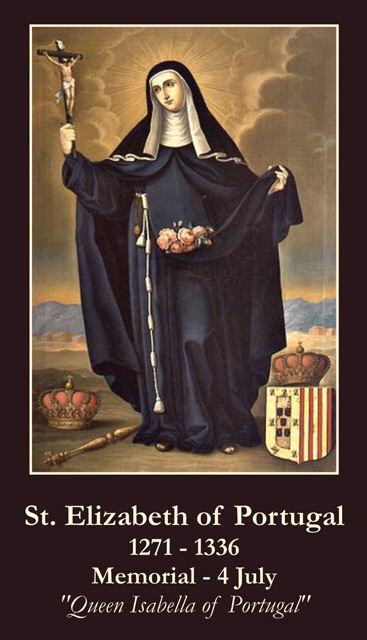She was named after her great-aunt Saint Elizabeth of Hungary, but was known in Portuguese and Spanish as Isabel. She was the younger sister of King Alfonso III of Aragon and King James II of Aragon. She was also the older sister of King Frederick III of Sicily.
She married King Denis of Portugal in 1281.
They had two children:
Constance, who married King Ferdinand IV of Castile;
Afonso (who later became King Afonso IV of Portugal).
Elizabeth would serve as peace keeper between her husband Denis and Afonso, during the Civil War between 1322 and 1324. Denis of Portugal was prevented from killing his son through the intervention of the Queen. As legend holds, in 1323, Elizabeth, mounted on a mule, positioned herself between both opposing armies on the field of Alvalade in order to prevent the combat. Peace returned in 1324, once the illegitimate son was sent into exile, and the Infante swore loyalty to the king.
After the death of Afonso, Elizabeth retired to the monastery of the Poor Clare nuns, now known as the Monastery of Santa Clara-a-Velha (which she had founded in 1314) in Coimbra.
She was called to act once more as a peacemaker in 1336, when Alfonso IV marched his troops against King Alfonso XI of Castile, to whom he had married his daughter Maria, and who had neglected and ill-treated her. In spite of age and weakness, the Queen-dowager insisted on hurrying to Estremoz, where the two kings' armies were drawn up. She again stopped the fighting and caused terms of peace to be arranged. But the exertion brought on her final illness. As soon as her mission was completed, she took to her bed with a fever from which she died on July 4, in the castle of Estremoz.
Elizabeth was buried in the Convent of Santa Clara (later the Monastery of Santa Clara-a-Velha) in Coimbra, in a magnificent Gothic sarcophagus. After frequent flooding by the Mondego River in the 17th century, the Poor Clares moved her mortal remains to the Monastery of Santa Clara-a-Nova (also in Coimbra). Her body was transferred to the main chapel, where it was buried in a sarcophagus of silver and crystal.
Miracles were said to have followed upon her death. She was beatified in 1526 and canonized by Pope Urban VIII on 25 May 1625. Her feast day is July 4.
She was named after her great-aunt Saint Elizabeth of Hungary, but was known in Portuguese and Spanish as Isabel. She was the younger sister of King Alfonso III of Aragon and King James II of Aragon. She was also the older sister of King Frederick III of Sicily.
She married King Denis of Portugal in 1281.
They had two children:
Constance, who married King Ferdinand IV of Castile;
Afonso (who later became King Afonso IV of Portugal).
Elizabeth would serve as peace keeper between her husband Denis and Afonso, during the Civil War between 1322 and 1324. Denis of Portugal was prevented from killing his son through the intervention of the Queen. As legend holds, in 1323, Elizabeth, mounted on a mule, positioned herself between both opposing armies on the field of Alvalade in order to prevent the combat. Peace returned in 1324, once the illegitimate son was sent into exile, and the Infante swore loyalty to the king.
After the death of Afonso, Elizabeth retired to the monastery of the Poor Clare nuns, now known as the Monastery of Santa Clara-a-Velha (which she had founded in 1314) in Coimbra.
She was called to act once more as a peacemaker in 1336, when Alfonso IV marched his troops against King Alfonso XI of Castile, to whom he had married his daughter Maria, and who had neglected and ill-treated her. In spite of age and weakness, the Queen-dowager insisted on hurrying to Estremoz, where the two kings' armies were drawn up. She again stopped the fighting and caused terms of peace to be arranged. But the exertion brought on her final illness. As soon as her mission was completed, she took to her bed with a fever from which she died on July 4, in the castle of Estremoz.
Elizabeth was buried in the Convent of Santa Clara (later the Monastery of Santa Clara-a-Velha) in Coimbra, in a magnificent Gothic sarcophagus. After frequent flooding by the Mondego River in the 17th century, the Poor Clares moved her mortal remains to the Monastery of Santa Clara-a-Nova (also in Coimbra). Her body was transferred to the main chapel, where it was buried in a sarcophagus of silver and crystal.
Miracles were said to have followed upon her death. She was beatified in 1526 and canonized by Pope Urban VIII on 25 May 1625. Her feast day is July 4.
